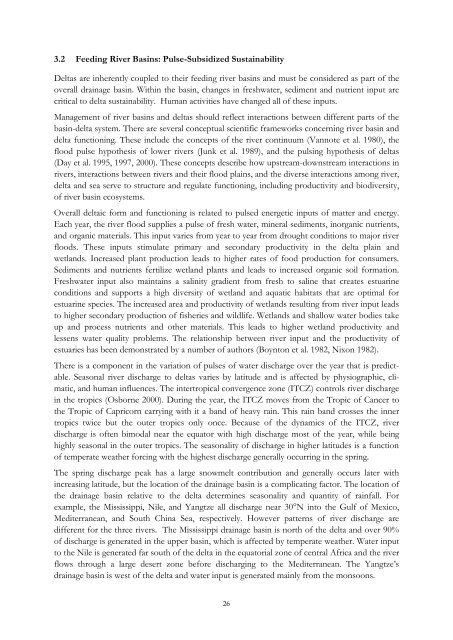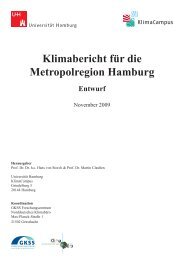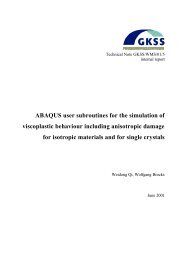Dynamics and Vulnerability of Delta Systems - loicz
Dynamics and Vulnerability of Delta Systems - loicz
Dynamics and Vulnerability of Delta Systems - loicz
You also want an ePaper? Increase the reach of your titles
YUMPU automatically turns print PDFs into web optimized ePapers that Google loves.
3.2 Feeding River Basins: Pulse-Subsidized Sustainability<br />
<strong>Delta</strong>s are inherently coupled to their feeding river basins <strong>and</strong> must be considered as part <strong>of</strong> the<br />
overall drainage basin. Within the basin, changes in freshwater, sediment <strong>and</strong> nutrient input are<br />
critical to delta sustainability. Human activities have changed all <strong>of</strong> these inputs.<br />
Management <strong>of</strong> river basins <strong>and</strong> deltas should reflect interactions between different parts <strong>of</strong> the<br />
basin-delta system. There are several conceptual scientific frameworks concerning river basin <strong>and</strong><br />
delta functioning. These include the concepts <strong>of</strong> the river continuum (Vannote et al. 1980), the<br />
flood pulse hypothesis <strong>of</strong> lower rivers (Junk et al. 1989), <strong>and</strong> the pulsing hypothesis <strong>of</strong> deltas<br />
(Day et al. 1995, 1997, 2000). These concepts describe how upstream-downstream interactions in<br />
rivers, interactions between rivers <strong>and</strong> their flood plains, <strong>and</strong> the diverse interactions among river,<br />
delta <strong>and</strong> sea serve to structure <strong>and</strong> regulate functioning, including productivity <strong>and</strong> biodiversity,<br />
<strong>of</strong> river basin ecosystems.<br />
Overall deltaic form <strong>and</strong> functioning is related to pulsed energetic inputs <strong>of</strong> matter <strong>and</strong> energy.<br />
Each year, the river flood supplies a pulse <strong>of</strong> fresh water, mineral sediments, inorganic nutrients,<br />
<strong>and</strong> organic materials. This input varies from year to year from drought conditions to major river<br />
floods. These inputs stimulate primary <strong>and</strong> secondary productivity in the delta plain <strong>and</strong><br />
wetl<strong>and</strong>s. Increased plant production leads to higher rates <strong>of</strong> food production for consumers.<br />
Sediments <strong>and</strong> nutrients fertilize wetl<strong>and</strong> plants <strong>and</strong> leads to increased organic soil formation.<br />
Freshwater input also maintains a salinity gradient from fresh to saline that creates estuarine<br />
conditions <strong>and</strong> supports a high diversity <strong>of</strong> wetl<strong>and</strong> <strong>and</strong> aquatic habitats that are optimal for<br />
estuarine species. The increased area <strong>and</strong> productivity <strong>of</strong> wetl<strong>and</strong>s resulting from river input leads<br />
to higher secondary production <strong>of</strong> fisheries <strong>and</strong> wildlife. Wetl<strong>and</strong>s <strong>and</strong> shallow water bodies take<br />
up <strong>and</strong> process nutrients <strong>and</strong> other materials. This leads to higher wetl<strong>and</strong> productivity <strong>and</strong><br />
lessens water quality problems. The relationship between river input <strong>and</strong> the productivity <strong>of</strong><br />
estuaries has been demonstrated by a number <strong>of</strong> authors (Boynton et al. 1982, Nixon 1982).<br />
There is a component in the variation <strong>of</strong> pulses <strong>of</strong> water discharge over the year that is predictable.<br />
Seasonal river discharge to deltas varies by latitude <strong>and</strong> is affected by physiographic, climatic,<br />
<strong>and</strong> human influences. The intertropical convergence zone (ITCZ) controls river discharge<br />
in the tropics (Osborne 2000). During the year, the ITCZ moves from the Tropic <strong>of</strong> Cancer to<br />
the Tropic <strong>of</strong> Capricorn carrying with it a b<strong>and</strong> <strong>of</strong> heavy rain. This rain b<strong>and</strong> crosses the inner<br />
tropics twice but the outer tropics only once. Because <strong>of</strong> the dynamics <strong>of</strong> the ITCZ, river<br />
discharge is <strong>of</strong>ten bimodal near the equator with high discharge most <strong>of</strong> the year, while being<br />
highly seasonal in the outer tropics. The seasonality <strong>of</strong> discharge in higher latitudes is a function<br />
<strong>of</strong> temperate weather forcing with the highest discharge generally occurring in the spring.<br />
The spring discharge peak has a large snowmelt contribution <strong>and</strong> generally occurs later with<br />
increasing latitude, but the location <strong>of</strong> the drainage basin is a complicating factor. The location <strong>of</strong><br />
the drainage basin relative to the delta determines seasonality <strong>and</strong> quantity <strong>of</strong> rainfall. For<br />
example, the Mississippi, Nile, <strong>and</strong> Yangtze all discharge near 30°N into the Gulf <strong>of</strong> Mexico,<br />
Mediterranean, <strong>and</strong> South China Sea, respectively. However patterns <strong>of</strong> river discharge are<br />
different for the three rivers. The Mississippi drainage basin is north <strong>of</strong> the delta <strong>and</strong> over 90%<br />
<strong>of</strong> discharge is generated in the upper basin, which is affected by temperate weather. Water input<br />
to the Nile is generated far south <strong>of</strong> the delta in the equatorial zone <strong>of</strong> central Africa <strong>and</strong> the river<br />
flows through a large desert zone before discharging to the Mediterranean. The Yangtze’s<br />
drainage basin is west <strong>of</strong> the delta <strong>and</strong> water input is generated mainly from the monsoons.<br />
26





